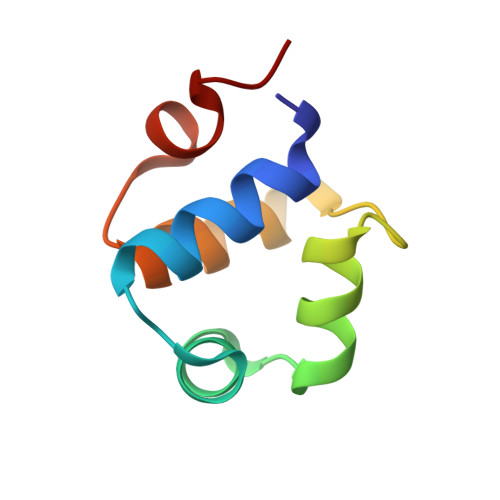Crystal structure of the transcriptional repressor DdrO: insight into the metalloprotease/repressor-controlled radiation response in Deinococcus.
de Groot, A., Siponen, M.I., Magerand, R., Eugenie, N., Martin-Arevalillo, R., Doloy, J., Lemaire, D., Brandelet, G., Parcy, F., Dumas, R., Roche, P., Servant, P., Confalonieri, F., Arnoux, P., Pignol, D., Blanchard, L.(2019) Nucleic Acids Res 47: 11403-11417
- PubMed: 31598697
- DOI: https://doi.org/10.1093/nar/gkz883
- Primary Citation of Related Structures:
6RMQ, 6RNX, 6RNZ, 6RO6 - PubMed Abstract:
Exposure to harmful conditions such as radiation and desiccation induce oxidative stress and DNA damage. In radiation-resistant Deinococcus bacteria, the radiation/desiccation response is controlled by two proteins: the XRE family transcriptional repressor DdrO and the COG2856 metalloprotease IrrE. The latter cleaves and inactivates DdrO. Here, we report the biochemical characterization and crystal structure of DdrO, which is the first structure of a XRE protein targeted by a COG2856 protein. DdrO is composed of two domains that fold independently and are separated by a flexible linker. The N-terminal domain corresponds to the DNA-binding domain. The C-terminal domain, containing three alpha helices arranged in a novel fold, is required for DdrO dimerization. Cleavage by IrrE occurs in the loop between the last two helices of DdrO and abolishes dimerization and DNA binding. The cleavage site is hidden in the DdrO dimer structure, indicating that IrrE cleaves DdrO monomers or that the interaction with IrrE induces a structural change rendering accessible the cleavage site. Predicted COG2856/XRE regulatory protein pairs are found in many bacteria, and available data suggest two different molecular mechanisms for stress-induced gene expression: COG2856 protein-mediated cleavage or inhibition of oligomerization without cleavage of the XRE repressor.
Organizational Affiliation:
Aix Marseille Univ, CEA, CNRS, BIAM, Molecular and Environmental Microbiology Team, Saint Paul-Lez-Durance, F-13108, France.















